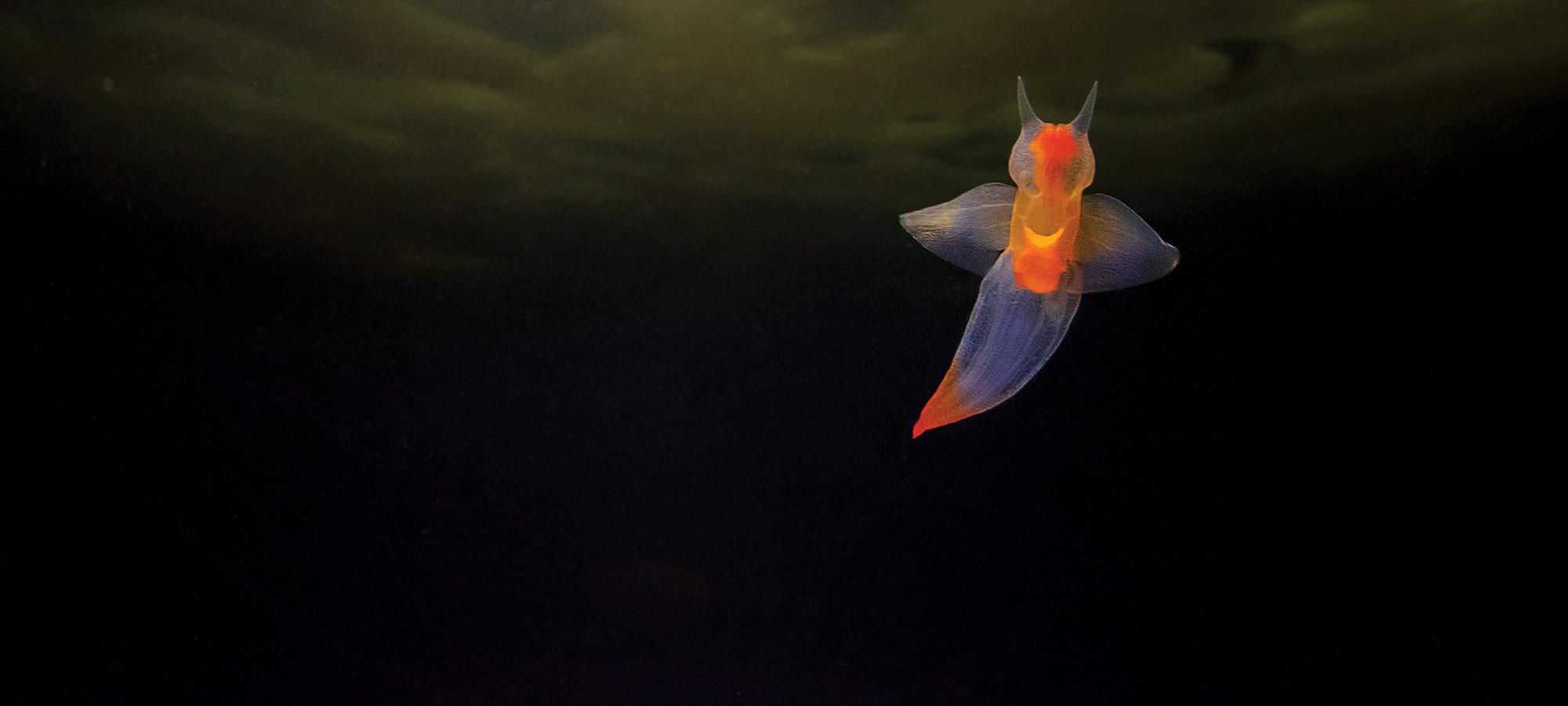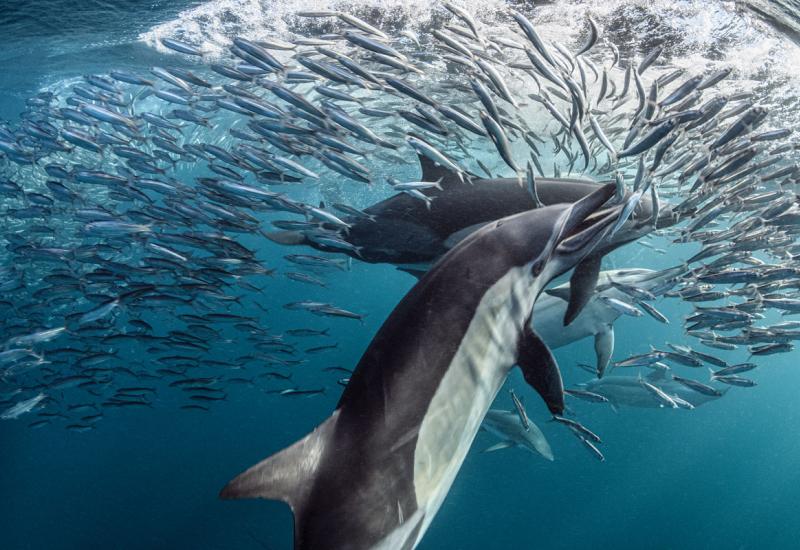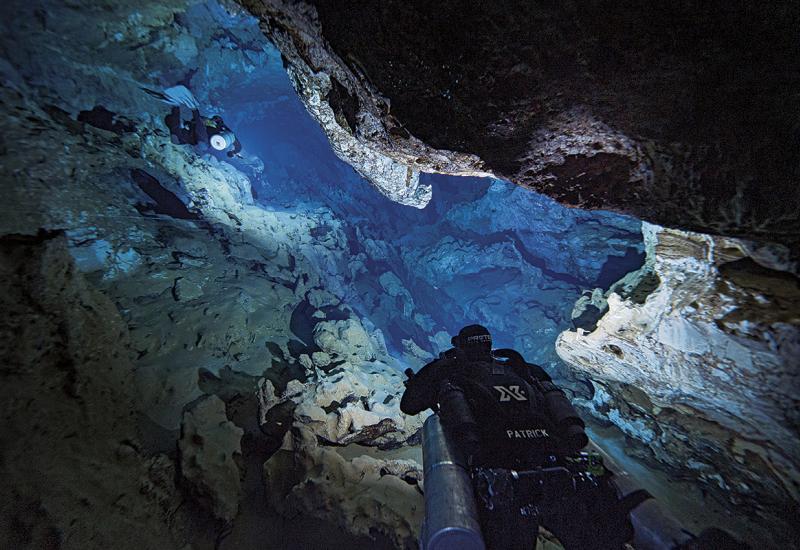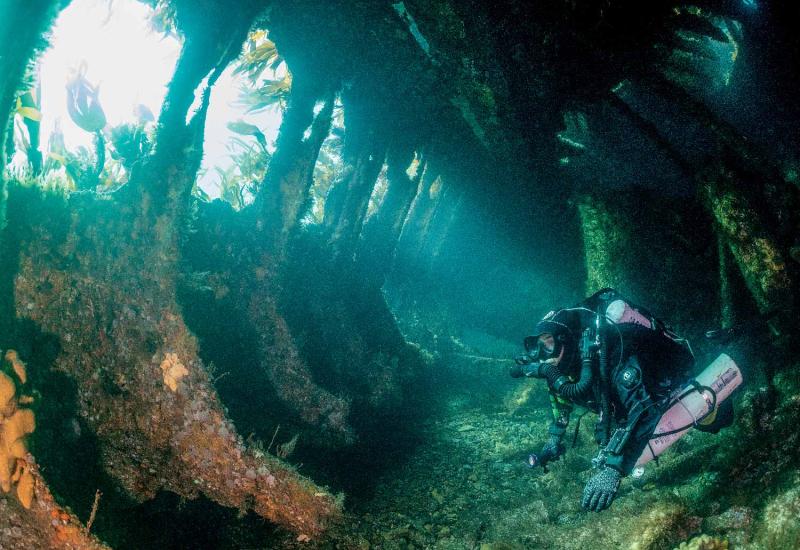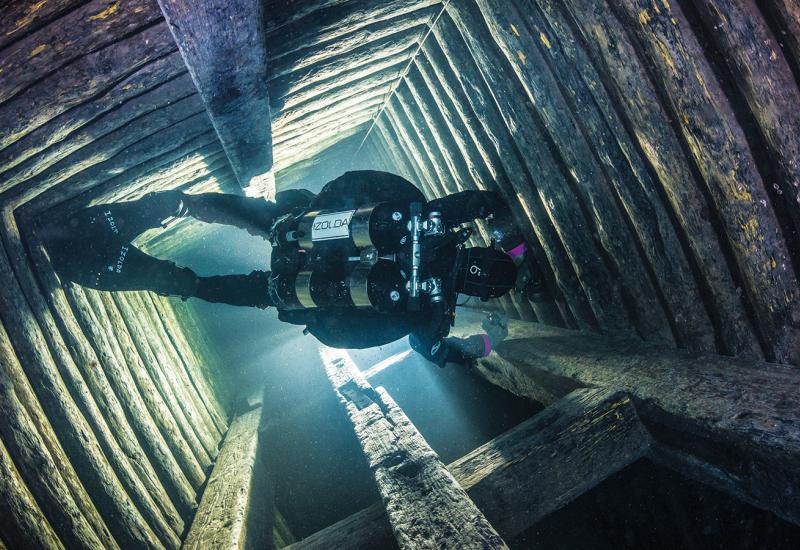Hunting for an Angel
The sled jumps on the snow drift and the soup pots clank, a thick scent of meatballs rippling out over the icy expanse of the White Sea.
For a month now, our National Geographic film crew has been working beyond the Arctic Circle, photographing the underwater life of the only European sea that freezes.
In the mornings, we leave Arctic Circle Dive Centre and Lodge and head to dive sites under the ice, taking our lunch and hot water in thermoses, and returning late in the evening. Night brings frost and temperatures down to minus 40 degrees F; on such evenings the northern lights shine especially brightly, but we are too exhausted to photograph them.
The White Sea in winter fully justifies its name, covered with a 5-foot layer of ice and powdered snow. If you didn’t know there was a water column below, you would think this was all snowy steppe. But the ice shell breathes beneath you; obeying the daily rhythm of the tides, it rises upward then sinks 6 feet back down, breaking off at the rocky coastline and freezing all over again. The calendar says it’s the end of March, the first month of spring, but the cold firmly holds the sea in icy immurement. That was, until yesterday.
Yesterday morning, the pale sun rose a little differently. It seemed to wake up after a long illness and shine at last — we had forgotten that, somewhere, it might be warm.
Photographer Viktor Lyagushkin and I are sitting in a sled following the snowmobile; another sled with equipment is being dragged behind us. We are heading far out and will return to the lodge only for dinner. Our assistant drives the snowmobile, which threatens to overheat from the long trip; our driver calls for a stop. Viktor lights a cigarette — he never misses a chance to smoke. I spy a harp seal about 100 feet out on the ice, basking in the sun. It clearly doesn’t want to go back in the icy water, but it doesn’t like our presence either, and so the seal dives away.
Curiosity makes me investigate the hole through which the animal breathes and exits the water. In Russian, such a hole has a special name: prodykh. There are nine different words in Russian for a hole in the ice. Lunka is a small hole for fishing; mayna is a big one, big enough for a person to squeeze through. There are words for ravines washed with current or sunshine, a word for open water that appears when ice diverges. Winter at this end of the Earth lasts a long time; in order to survive, people needed to be able to describe conditions of the sea under the ice.
This seal hole is quite large; I could get into it. Perfectly round, with tooth marks on the ice. I peer into the dark water until my fellow travelers wave me back; the snowmobile has cooled and it’s time to get going.
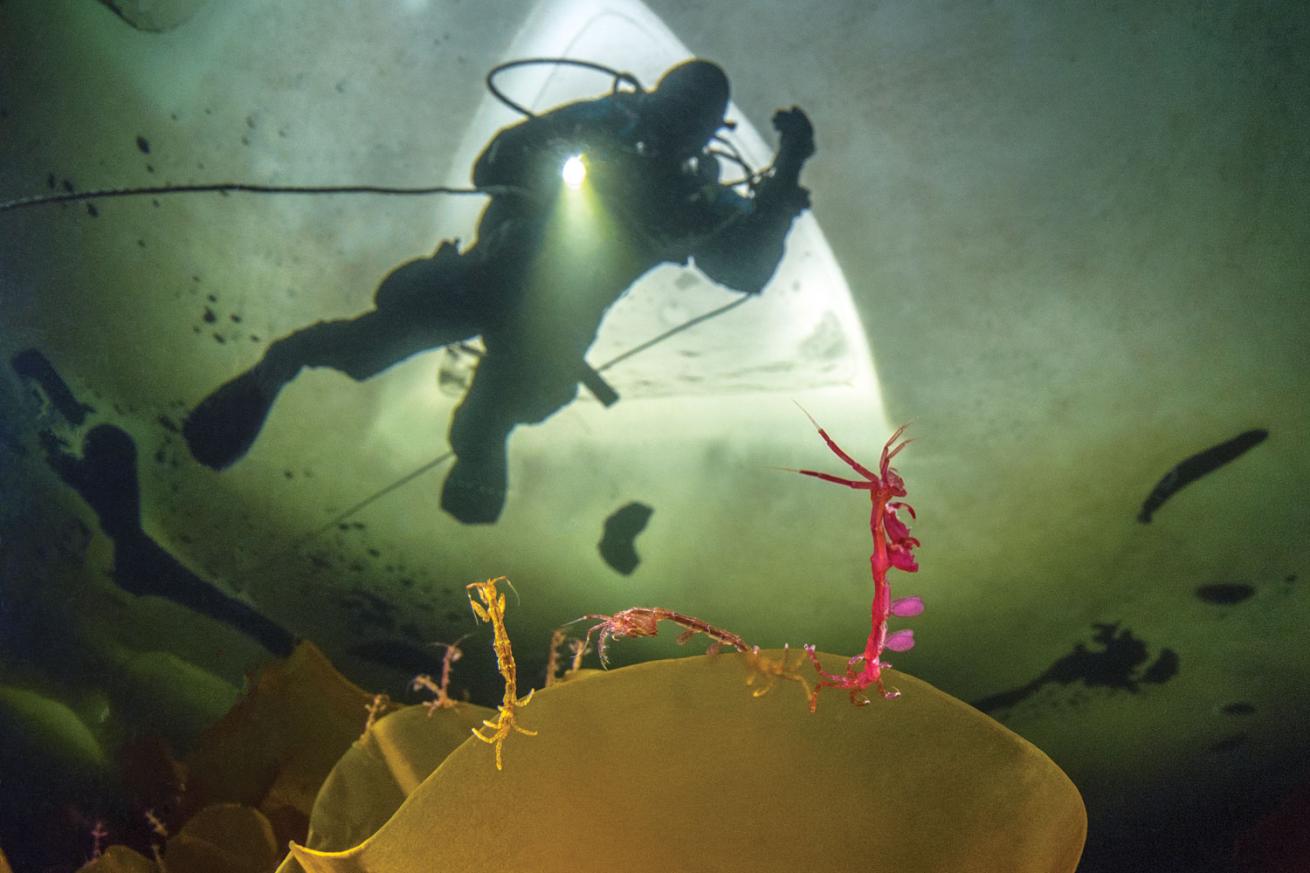
Viktor LyagushkinThe author observes skeleton shrimps, social and active animals that fight with each other nonstop.
A Shrimp Metropolis
At Beluga Whale Rock, about 15 miles from the dive center, a small plywood hut on runners with a wood stove has been set up and heated that morning, and a mayna cleared of ice is waiting for us. It’s warmer on the surface, but the water hasn’t warmed up a bit — still 28 degrees F. Sitting on the edge of the mayna putting on my fins, I remember the seal and peer into the distance. A dark dot has appeared again on the blinding white field — the beast waited until we left and climbed back out. Good for him; he can lie all day under the sun while we submerge.
Beluga Whale Rock is overgrown with bushes of Laminaria. In the White Sea, two types of kelp are most common. As Mikhail Safonov, a marine biologist and director of Arctic Circle Dive Centre on the west side of the White Sea, jokes, these two species are easy to distinguish — one is beautiful (Laminaria digitata, or drift weed), and the other is tasty (Laminaria saccharina, or sugar blade kelp).
The kelp leaves are covered with lacy hydroids where nudibranchs crawl, lazily eating them. But we have come for another local inhabitant — Caprella, or skeleton shrimp. There are thousands of them here, maybe tens of thousands, a shrimp metropolis. Caprellas cling to wide brown sheets of kelp, close to each other, large and small, red and white, purple and yellow. I could watch them forever — how they catch something from the flow, widely spreading their claws, or brush their antennae, or lean toward each other to “confer.” Two Caprellas — a big red one and a small yellowish one — start a fight. Their neighbors interfere with delight, and now five small shrimps of all colors hang on the bully and wriggle as Big Red tries to shake them off.
Read More: Scuba Diving Through Slovakia's Opal Mines
As we dive, it gets noticeably darker. Apparently, the weather is deteriorating. My bottom timer reads 1:10, and I show Viktor that I am cold, pitifully asking to go up. We come to the mayna and see that our safety rope now leads into a snowbank! How strange it is to leave the surface with the sun shining and return to a raging snowfall.
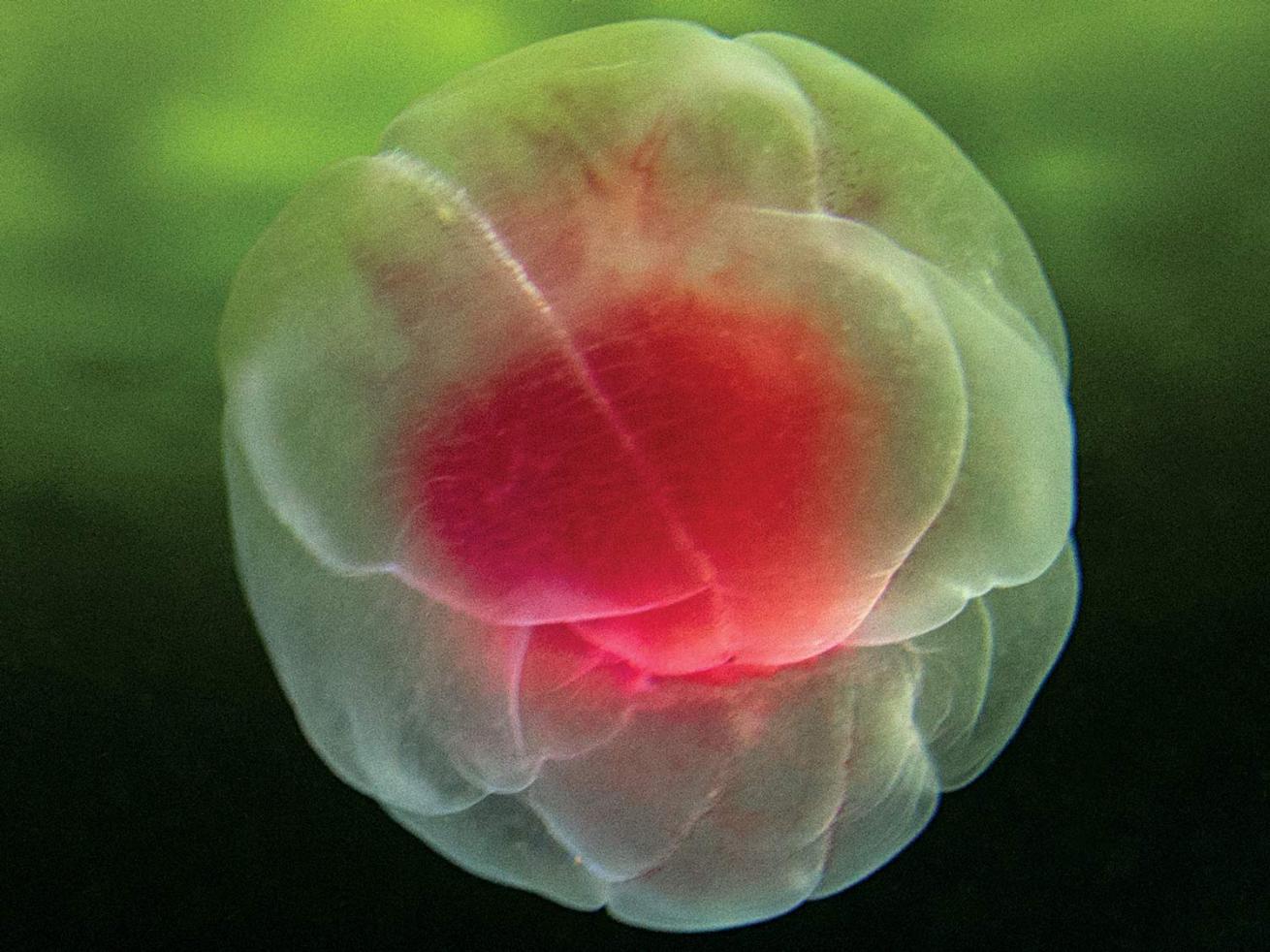
Viktor LyagushkinBolinopsis infundibulum has no tentacles and eats other comb jellies.
Rites of Spring
How does the underwater world know that spring is just around the corner? Almost nothing changes on the surface, but events under the ice begin to occur at an incredible speed, with more and more new animals appearing every day. They mate, eat each other, and grow, snatching their chance to fulfill their destiny while the polar spring is in full swing.
Most of these strange-looking animals have neither Russian nor English names but only Latin ones, and they are found nowhere but the polar depths.
To survive winter under the ice, polar animals use various tricks. Some learn to be motionless to conserve their energy, and to present only a low-calorie meal, so that a predator would spend more energy hunting and digesting than it would receive from eating them. Others put on strong armor, learning to use venom — their own or something else’s.
It would be logical to assume that warm-blooded mammals cannot survive this icy hell, where a huge amount of energy is required to maintain the temperature of one’s own body. But this is not the case. High body temperature allows these animals to move with great speed, making it an incredibly effective survival technique. And so the Arctic seas became home to millions of seals and hundreds of thousands of belugas and killer whales.
Spring here is swift. In just two weeks, the seemingly indestructible sea-ice shell darkens; scours appear in the straits where the current is especially strong, and ice floes float in open water. A snowmobile going out on the ice no longer squeaks merrily on dry snow but roars and strains, choking on the deep, wet porridge. Fresh water flows under the ice, and haloclines appear — a trembling haze a yard thick and more. Ice-diving season is coming to an end.
We decide to return to Beluga Whale Rock while it’s still possible to get there because divers have seen angels there. It’s not a mystical experience we’re seeking but instead a sea slug known as a sea angel.
We prepare carefully for the hunt. Working with scientists, we had developed a plan of attack. Like two sharks, Viktor and I face the current — which is getting stronger — and observe beings that rush past. Since the beginning of spring, there are more and more things riding the tide, from the omnivorous comb jelly Bolinopsis infundibulum, and its enemy the Beroe, to various types of crustaceans and the swift, transparent arrow Parasagitta.
We photograph everyone we meet, diving for an hour; when we exit, Viktor is shaking from the cold. (Me too.) We doff our drysuits in a heated hut and warm ourselves with tea.
Viktor, as usual, looks at the shots through his Subal housing and frowns with displeasure. The weather is overcast; snowfall has made the snow cover quite thick, and there is too little light under the ice. The photos are not good, and we did not meet an angel.
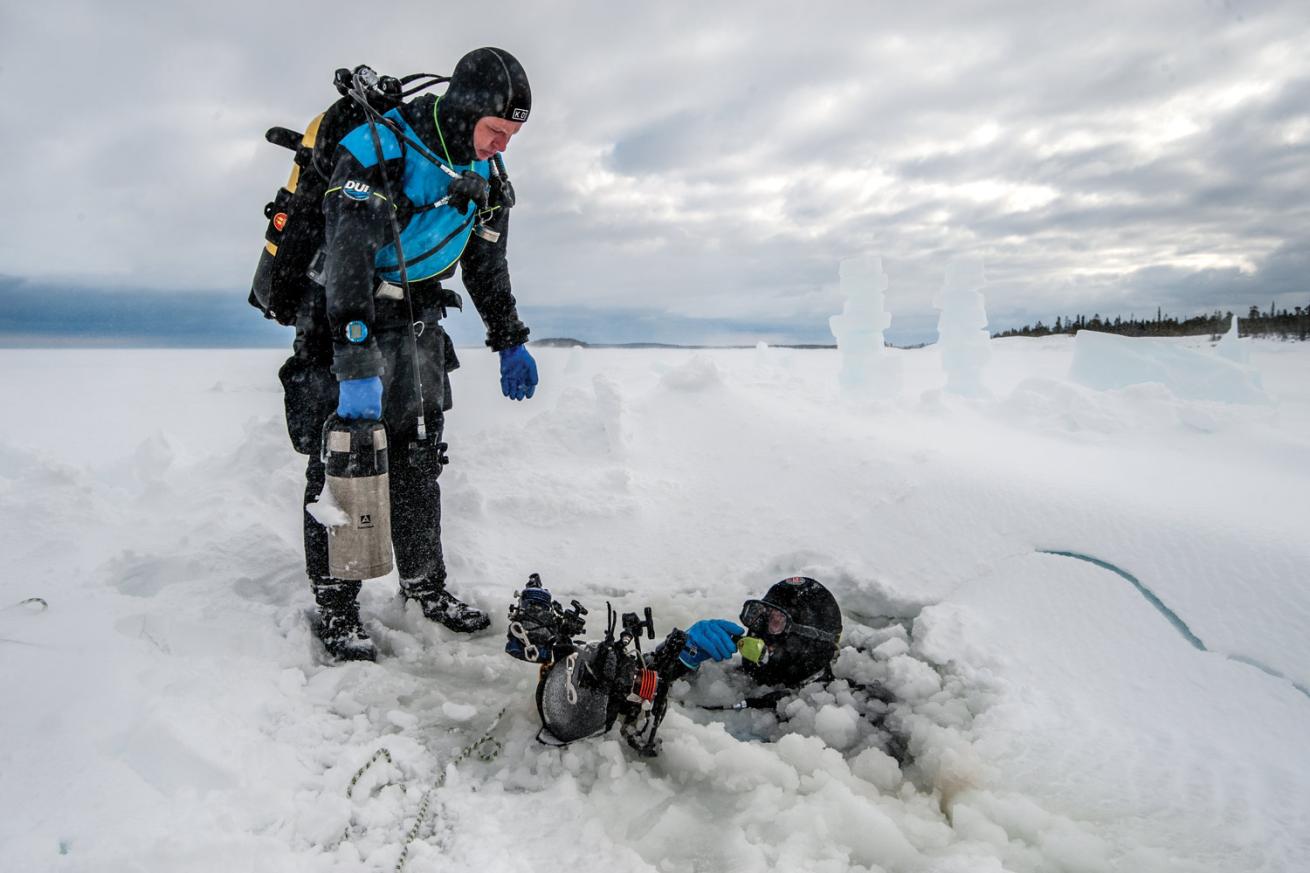
Viktor LyagushkinThe author prepares to pour hot water on the photographer’s freezing reg.
A Pocketful of Ctenophora
After dinner, we go to the banya, a sort of Slavic steam bath, to warm up. This is mandatory because cold is cunning, and cold fatigue tends to accumulate, like nitrogen. When the discomfort of the dives is forgotten, Viktor emerges beet-faced from the steam room, announcing the result of his reflections: We must clear the ice of snow so sunlight can fall freely on the water. Our crew meets his Napoleonic demand with enthusiasm. It sounds ridiculous — find a fire truck to shoot water on the snow, hire workers with shovels to clear the site, and so on. Safonov throws a wet blanket on our ideas, advising us to first try more realistic methods. He promises to send assistants.
The next day we go again to Beluga Whale Rock. The weather is good — bright sun, but Viktor is sure this is not enough. We need to do something about the snow. We explore the surface above the shooting location, splashing buckets of water around — in vain: The snow is too thick and easily absorbs it. We circle the mayna in thought. A crust has formed on the snow, but under our feet, water appears in our prints. We remember that footprints are visible from below and begin to trample the snow with enthusiasm, whooping and singing until our driver thinks to rev the engine of the snowmobile — much more efficient and less effort.
We dive in at last, and — hurray! — it worked. It’s much lighter under the trampled places; we hope it will be enough. The tide begins to turn, and the stream accelerates faster. Today the sea ferries some unappetizing brown threads — unappetizing for us, but the skeleton shrimp definitely consider it the opposite. The whole colony feasts, catching brown bits flying past with their claws and fighting for a bigger piece. I’m trying to determine what the brown stuff is. Eventually it comes to me — this is a layer of either algae or bacteria that has grown on the underside of the ice. As the ice begins to thaw, the bacterial layer comes off and is washed away, to the joy of all creatures living under the ice.
Ctenophora and jellyfish swim past us again, along with various crustaceans. A crab comes out into the open space beneath me; it’s mating season. But for some reason, once again, no angels. We search for an hour and a half without success. Silently we eat our lunch in a warm hut. We have not been lucky.
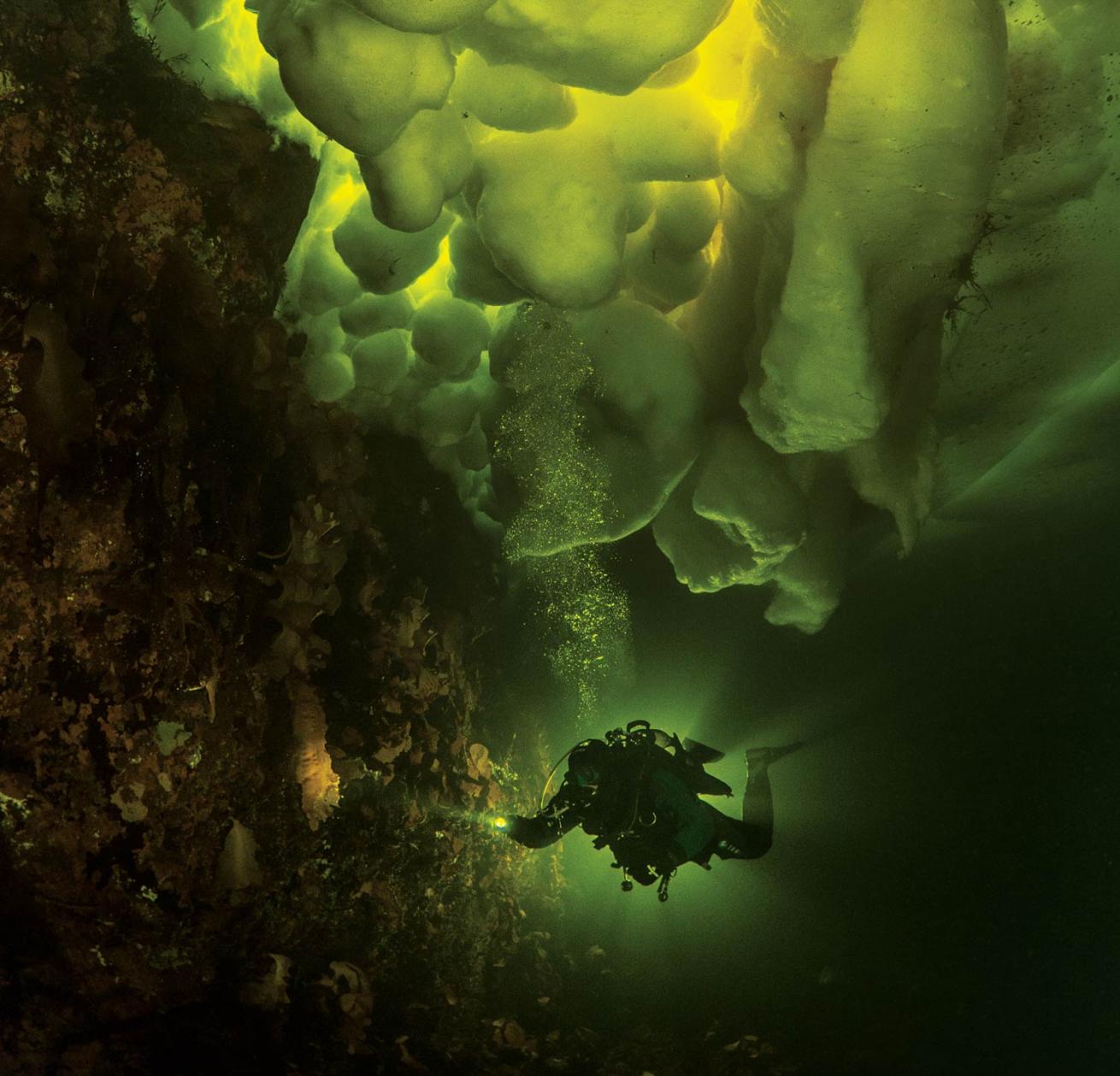
Viktor LyagushkinA diver swims under White Sea ice hummocks; tides here are so strong that they can break up 5-foot-thick ice and create majestic sculptures.
As it turns out, our bad luck is just beginning. Before putting on his drysuit for the second dive, Viktor goes to relieve himself in a small hut about 30 feet away. On the way back, in front of our astonished group, he suddenly drops to his waist in the snow. He begins to laugh, and slips to his chest. Cold and wet, he shouts for help. It turns out he has fallen into the mayna from yesterday, which was covered with snow, leaving no signs on the surface — a perfect trap.
His undergarments wet through, pockets full of crustaceans and ctenophora, he’s as gloomy as a demon. A very cold demon.
With our luck worsening, should we call the dive? It doesn’t seem that we are destined to meet an angel this time. But Viktor is tough. He changes into jeans and a sweater, his drysuit on top, and we enter the water. The tide has already lost its strength, and the water slowly ferries fantastic animals of spring on its back. It’s easier to shoot them, but we are no longer interested. Viktor is quickly freezing and indicates it’s time to go.
Suddenly the ray of my light outlines a magical creature that seems to shine from within. Defenseless and touching, it flutters its wings and dances in front of Viktor’s dome port. An angel has appeared to us. I stare hard as it rolls and twirls; it’s hard to shed the feeling that it is aware of us, and posing. I remind myself that cannot be so — the sea angel is a mollusk, and what seems to us to be wings is a leg. Its “head” is tentacles, clenched into a fist, and its “heart” is a stomach. But this doesn’t diminish my delight at all.
We get the shots we wanted, and now are free to go home to Moscow, which is full of young green foliage, flowering cherries and warm starry nights. But in my dreams, a place appears where my soul sometimes returns: the Arctic Circle, where Caprellas and seals dwell under the ice and snow, and angels fly, lighthearted and beautiful.
Need To Know
When to Go: There are two seasons for diving the White Sea: ice season, which lasts from mid-February till early April, and “no-ice” season, from mid-May till mid-October.
Dive Conditions: Winter temperatures are challenging: around 30°F water temperature and from minus 31°F to 41°F on the surface. Hardy winter divers will be rewarded with good visibility (80 to 130 feet), gardens of soft corals, and colorful sea anemones, nudibranchs and sea stars. When the ice melts is the best time for seal-watching, from late April till mid-May. After that the water becomes warmer, reaching 68°F, which brings big Aurelia and lion’s mane jellyfish. Summer brings 40-minute drift dives up to a mile long; night dives with glowing plankton under the northern lights are possible in fall.
Travel Tip: To get to the Arctic Circle, take a flight to Moscow, and then another to Murmansk (a two-and-a-half-hour flight), and then a four- to five-hour drive to the dive center. You will probably need a Russian visa.
Operator: Arctic Circle Dive Centre offers wonderful service and accommodations, plus hiking trails, ski routes, and its own sled dogs and reindeer. Its staff speaks English, and the center even offers programs where children learn and play while their parents dive.
Price Tag: It’s $540 per person for meals and accommodations for five days; diving prices vary by season. Five days of two dives per day is $840 in winter, $520 in other seasons.
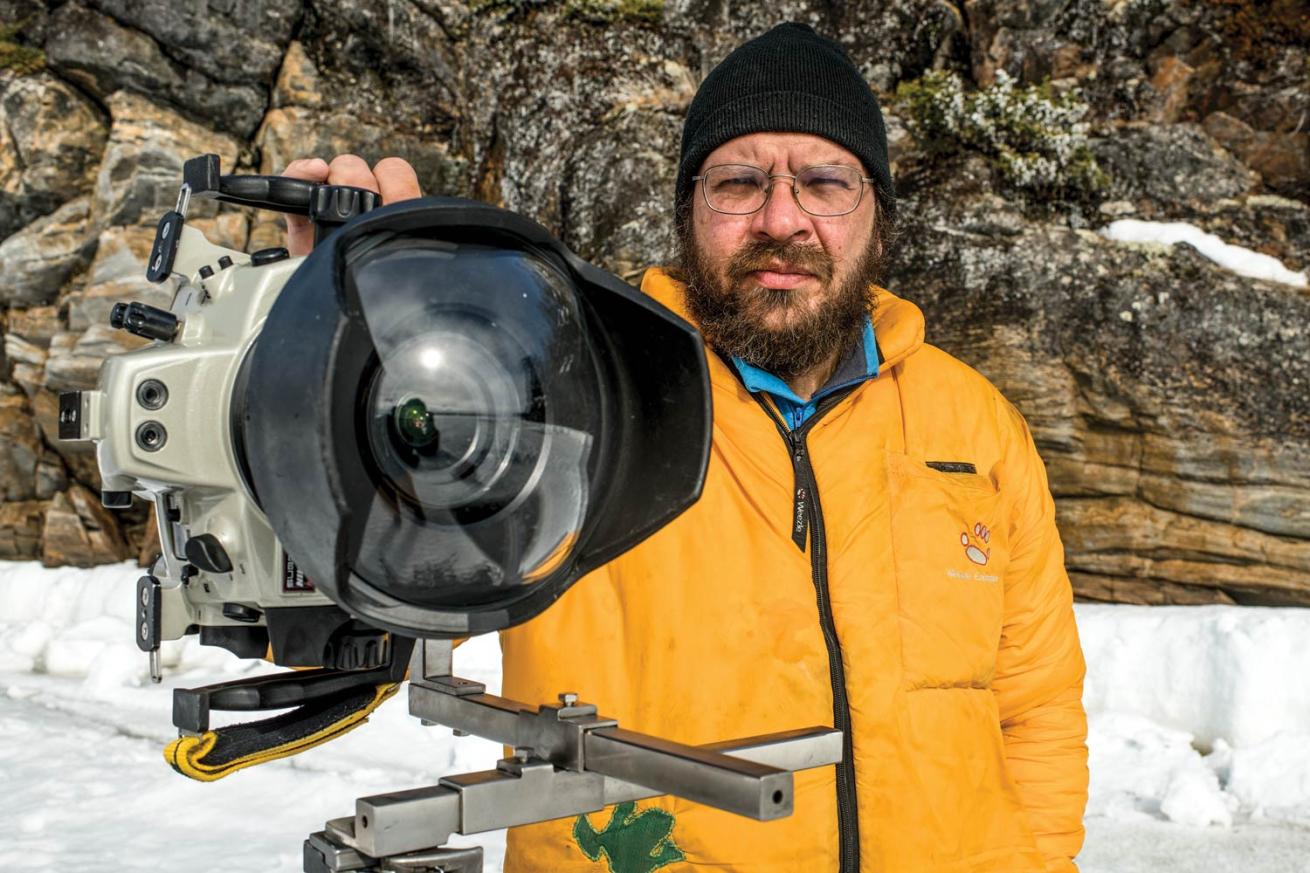
Viktor LyagushkinThis project was shot with a Nikon D4S and D750 in Subal housings. Viktor, above, now uses a D850 in Subal housing.
Viktor Lyagushkin’s Rig
This project was shot with a Nikon D4S and D750 in Subal housings. The “macro fisheye” look is possible due to the Nikon lens AF-S Nikkor 8-15/3.5-4.5 E ED Fisheye. For light, he used Ikelite DS160 strobes, Scurion lights, Light Monkey HID 21W and Scubalamp torches.
5 Tips for Shooting in the White Sea
- Use a metal housing because of frost and big temperature differences.
- Use the most sensitive camera you can; ice and snow absorb sunlight, and it’s pretty dark under the ice.
- Get a warm bag or covering for your housing. Assemble your camera rig in your room and put it into something warm, otherwise it might run out of battery before you get into the water.
- Ice-diving gloves are thick; be ready for that by practicing with thick gloves in a pool to get comfortable.
- Look up! You have an additional element for creating your shots over your head. Ice is beautiful, and you may get unusual and interesting pictures with it.

